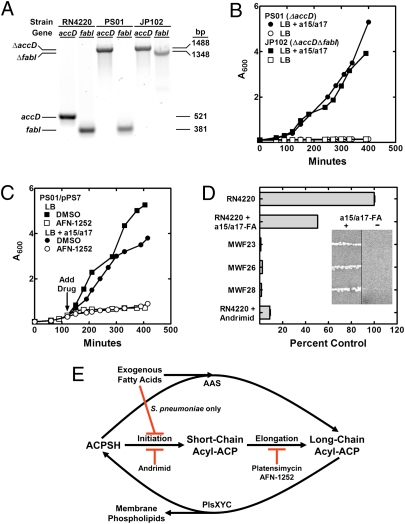Fig. 4.
Phenotypes of S. aureus ΔaccD and ΔaccD ΔfabI mutants. (A) PCR genotyping of strains RN4220 (wild-type), PS01 (ΔaccD), and JP102 (ΔaccD ΔfabI) showing the presence of the gene insertions in the knockout strains using gene-specific primers flanking the insertion site. (B) Strains PS01 (ΔaccD) and JP102 (ΔaccD ΔfabI) were fatty acid auxotrophs. (C) Complementation of S. aureus strain PS01 (ΔaccD) by plasmid pPS7 expressing the accDA operon. The complemented strain was growth inhibited by AFN-1252 (80 ng/mL) in both the presence and absence of fatty acids. (D) FASII activity in three fatty acid auxotrophs (strains MWF23, MWF26, and MWF28) were determined by labeling with [14C]acetate (10 μCi/mL) compared with wild-type strain RN4220 grown with or without an a15:0/a17:0 supplement. Strain RN4220 grown in the presence of andrimid (75 μg/mL) was analyzed also. Inset shows fatty acid auxotroph growth phenotypes on agar plates with and without a15:0/a17:0 supplements. (E) Regulation of FASII activity by fatty acids in S. pneumoniae but not in S. aureus. In S. pneumoniae, fatty acids feedback inhibits acetyl-CoA carboxylase and shuts off FASII. S. aureus lacks this stringent regulatory circuit.

